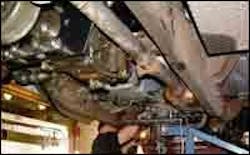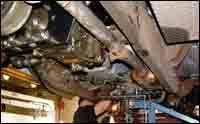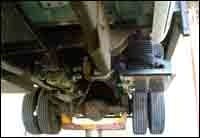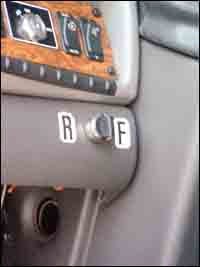SuperDrive System Claims High Fuel Gains
Fuel economy is not as big a deal with operators of construction trucks as it is with over-the-road truckers. So the prospect of saving a minimum of 20 percent on fuel may not grab your attention. If not, how about cutting 1,000 pounds or so from the weight of your Class 8 truck? Both are claimed benefits of the SuperDrive system from a small Ohio company of the same name.
SuperDrive Inc. has quietly begun marketing a system in which a low-speed diesel runs through a hydrostatic, continuously variable transmission, or CVT. The company promises a 1-million-mile warranty on the transmission, guarantees the 20 percent improvement, and also claims lower exhaust emissions.
SuperDrive is not a simple add-on. It requires alterations to a truck's drive train and engine modifications. Retrofitting is expensive and time-consuming, at least for each newly handled vehicle, which requires designing, fitting and fabrication of new brackets and other parts. But the system has been successfully tested in labs and on highways, where dyno and snap-idle tests have proven substantial reductions in particulates, NOx and other pollutants.
SuperDrive is the brainchild of Herman Mitchell, a prolific inventor who founded the firm in Piqua, Ohio, and is now its vice president for research & development. Ray Fleming, vice president of operations, says it has strong financial backing, and is getting orders from transit bus operators and talking seriously with several truck operators.
Up to now, SuperDrives have been retrofitted to existing trucks and buses at about $14,000 for a light truck, $19,000 for a medium, and $35,000 for a heavy. But one proposed deal for 50 road tractors would have the system installed at a factory modification center. This would cut the per-unit installation cost to about $15,000, Fleming said.
Retrofitting involves removing a vehicle's clutch and clutch linkage, transmission and drive shaft, then installing SuperDrive components. These include a hydraulic pump and driveline motor connected by hoses and fittings, which comprise the hydrostatic CVT. There's also a smaller pump that supplies compressed air for injection into the exhaust stream, and a compact electronic control module. The ECM works with engine controls to regulate fuel and rpm, and controls operation of the pumps and motor. Removal of the conventional drive train saves about 1,000 pounds in a Class 8 vehicle, even accounting for weight of the SuperDrive components, Fleming says.
The system's main pump, mounted behind the engine and driven by it, is an axial type with five cylinders arrayed around a swash plate; the plate moves to alter the cylinders' displacement, and therefore the flow of hydraulic fluid. This in turn constantly changes the drive ratio. Pressurized fluid runs through hoses to and from the motor that's mounted ahead of the rear axle's differential; a truck with a live tandem has two motors, one ahead of each differential.
Operating pressure is generally about 3,500 psi, but goes up to 5,000 psi when the system encounters high loads, such as when launching from a dead stop or beginning to climb a hill. The ECU notes the situation and orders more power from the engine and adjustments of the swash plate inside the axial pump. Fleming says the ECU's programming includes 48 ratio-type "steps" for the swash plate, but they are so closely spaced that changes are not noticeable to a driver.
Fluid leaks are the bane of any hydraulic system, but engineers are taking special care to use robust hoses and fittings. In production versions, piping may be used in some places to reduce the risk of leakage. Installations thus far use German-made equipment from Linde and Rietschle.
The operating range of a SuperDrive-equipped Class 8 diesel is about 800 to 1,300 rpm, which is 300 to 500 less than usual. This takes advantage of a diesel's torque peak, which is typically at 1,000 to 1,200 rpm. And it yields "fewer combustion events per mile" and allows more time for complete combustion, Fleming says, which are largely responsible for the fuel economy gains.
What about the "sweet spot" of most big diesels—the speed at which combustion is most efficient—which is 1,500 to 1,600 rpm? "We've extended the sweet spot" downward by keeping turbocharger boost up in light-load conditions, he answers. It's done by injecting compressed air into the exhaust manifold upstream of the turbo. Air comes from the hydraulically driven air pump, which is also controlled by the ECU. Cool air lowers exhaust temps, which cuts formation of NOx.
The system's components can be sized to work in all classes of turbocharged diesels. Technicians recently installed a system in a Chevrolet 3500 with a Duramax V-8 diesel. The truck is owned by APS Energy in Phoenix, which wants to try it out before committing to more buys. The system will also work in non-turbocharged engines, such as the gasoline Triton V-10 in a Ford Excursion, now being converted at SuperDrive's home facility.
Axle gearing is not nearly as critical as with a ratio-step manual or automatic transmission. Because of hydraulics, "the engine is uncoupled from wheel speed," Fleming explains. The ECU can be programmed and the pump and motor adjusted to work with an existing axle ratio, as was done with the Chevy 3500.
Or the axle can be changed to enhance performance, as on a Kenworth T800 demonstration tractor, which has two axle ratios. One is the stock 3.73, while the ring and pinion gears in the other diff were changed to a 5.29. At low speeds, more fluid goes to the motor coupled to the "slow" 5.29 diff; as the truck accelerates, fluid is split between the two differentials, and at highway speeds, most fluid goes to the motor at the 3.73 diff.
The KW T800 demo tractor I drove had a 425-hp Caterpillar C-12 under the hood. Following instructions, I started the engine, then twisted a dash-mounted selector knob from neutral to F (forward), released the parking brakes and stepped on the accelerator. The engine revved and off we went. There was no rising and dropping of rpm because there are no perceptible ratio steps to climb.
The C-12 revved to about 1,300 during acceleration, then dropped back to under 1,000 as cruising speed was approached. Revs climbed slightly as I nudged the tractor toward 60 mph; there, engine speed was about 1,100. At 65 mph it cruises at about 1,150, which of course is 400 to 500 less than what's normal practice in most heavy trucks.
We were running bobtail on a boulevard outside of San Antonio, and the truck was as fast from a traffic light as most cars. There are no gear-change interruptions, just smooth power. I wish we'd had a heavy trailer to tell me how the system felt under load. But the tractor's regular driver, Phil Moser, said it pulls very well.
"With a loaded trailer, it's a little bit slower [than bobtail] on takeoff, but once you get moving it just picks up," he said. "It's a lot faster than a standard truck on takeoff. With two trucks, both at 80,000 pounds, you'd have a 6-second head start with the SuperDrive, if you were drag racing. With a manual transmission, you have five gear changes before 20 mph, but with this you don't have that."
Moser, who runs a small truck line out of Piqua, likes the SuperDrive because it cushions the driveline, is easy to drive and greatly improves fuel economy (he says the bobtailing demo tractor gets about 11 mpg, or twice the mileage it would with a manual transmission). Novice drivers can't damage U-joints because there aren't any, and there's nothing to know except the difference between Forward and Reverse, and SuperDrive has an almost-automatic hydraulic brake.
The retarder works by reversing the hydraulic motor, which then drags against the differential and axles. In the KW, two motors produce a lot of drag, and will completely stop the truck with no help from service brakes. The retarder begins working as soon as the driver takes his foot off the accelerator. Its output can be raised or lowered using the truck's original Jake Brake switches, with levels 1, 2 or 3. Moser said the retarder's strength and its point of actuation can be programmed to suit the truck's owner or driver.
Because it's fully automatic, SuperDrive would make a dumper or mixer driver's day an easy one, and help speed deliveries and boost a truck's productivity. Drivers who enjoy going through the gears might find it boring because there's nothing to do but steer and brake.
The high initial cost can be recouped fairly quickly from fuel savings, and the company says it has a leasing program available. Fleming says two major diesel manufacturers are intrigued with the idea, and one will begin testing it at Argonne National Laboratories if a DOE grant comes through. So it appears there's a future for this revolutionary concept.




